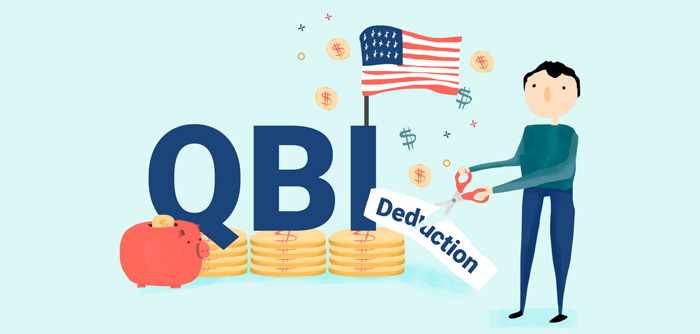How the income tax deduction benefit works for entrepreneurs
Anúncios
Accurate computation of Qualified Business Income (QBI) is essential for taxpayers deriving earnings from pass-through entities, paving the way for substantial tax savings. Strict adherence to Internal Revenue Service (IRS) guidelines is imperative to ensure a precise determination of the net amount of qualified items, encompassing income, gain, deduction, and loss from any qualified trade or business.

The intricacies inherent in QBI calculations demand a comprehensive understanding of qualified income and a keen awareness of limitations and exclusions stipulated by tax regulations. Consideration of the taxable income threshold becomes crucial, influencing the QBI deduction calculation and determining the applicability of specific limitations based on business type and the taxpayer’s income level.
The complexity of these calculations is further heightened by phase-in ranges dynamically adjusting the deduction amount. Meticulous attention to IRS rules and regulations is paramount to maximize the QBI deduction while ensuring full compliance with tax laws. Seeking guidance from a tax professional becomes invaluable in navigating the complexities of QBI calculations, ensuring accurate determination of the eligible deduction and optimization of tax savings.
Determining Taxable Income Levels
Before delving into the intricate calculations of the Qualified Business Income (QBI) deduction, taxpayers must establish their starting point: taxable income levels. Taxable income, akin to treasure amassed over the fiscal year, serves as the foundation from which deductions are subtracted, following the allowances granted by the tax code:
- Subtract the Essentials: Commence the journey by docking all standard or itemized deductions entitled to, excluding the QBI deduction itself. This strategic step ensures that only surplus provisions are considered after setting aside what’s deemed necessary for the voyage.
- Omit Non-QBI Treasures: Certain treasures, including capital gains or losses, dividends, interest income, and earnings from distant shores (foreign income), are stored in a different part of the fiscal ship. Notably, these do not contribute to your QBI calculations, allowing for a more precise determination of eligible income.
- Chart Your Starting Coordinates: For solo navigators (single filers), the journey embarks at $164,900 for the 2021 tax year, with yearly adjustments accommodating the changing tides of inflation. Partnerships (married filing jointly) commence their adventure at $329,800 for 2021, similarly subject to annual inflation adjustments.
This meticulous charting of starting coordinates provides taxpayers with a clear navigational map, ensuring an informed and strategic approach to the subsequent calculations of the QBI deduction. As the voyage unfolds, these anchoring steps lay the groundwork for optimizing tax benefits and navigating the seas of tax regulations with precision.
QBI Deduction Formula
Having charted your taxable income, you stand poised to embark on the expedition of calculating the Qualified Business Income (QBI) deduction—a treasure trove capable of reducing your taxable income by up to 20%. However, this quest entails several strategic steps:
- Identify Your QBI: Calculate the QBI for each business venture undertaken, meticulously excluding certain items such as wages paid to your crew (employees), capital gains, or interest income. These elements do not contribute to the QBI, ensuring a focused and accurate determination.
- Sail Through Limitations: Your income level may impose limitations, especially if you helm a Specified Service Trade or Business (SSTB) in fields like law, health, or consulting. These limitations progressively diminish the QBI deduction as your income ascends, necessitating a careful navigation strategy.
- Combine Your Treasures: For seasoned entrepreneurs juggling multiple ventures, the task involves amalgamating QBI amounts from each undertaking to calculate the total deduction. Mindful consideration of limitations based on your income level ensures a methodical approach, allowing taxpayers to accurately navigate their financial waters and claim the maximum entitled QBI deduction. This strategic voyage, if navigated sagaciously, holds the promise of substantial tax savings and enhanced resources to reinvest in your entrepreneurial adventures.
As you set sail on this quest for tax efficiency, a thoughtful and informed approach ensures not only the maximization of the QBI deduction but also the optimization of resources for future endeavors.
Implications and Considerations
The Qualified Business Income (QBI) deduction is like a treasure trove for folks with income from pass-through entities, offering a chance to save a pretty penny on taxes. But, as with any treasure, there’s a map filled with complex routes and hidden traps to navigate. Here’s a more human look at what this journey involves:

A Helping Hand in Tax Savings
Imagine being able to keep a bit more of your hard-earned money instead of sending it off to taxes. That’s the heart of the QBI deduction—a way for small business owners and self-employed individuals to potentially lower their taxable income by up to 20%. It’s like getting a “thank you” note from the tax code for contributing to the economy.
Navigating the Maze
However, this path isn’t without its twists and turns:
- Thresholds and Phase-outs: Think of these like levels in a game. The higher your income, the more challenging it becomes to claim your treasure (the deduction). Especially for those in certain service fields, where the rules get even trickier.
- SSTB Challenges: For those in professions like law, health, or consulting, it’s as if part of the map is blurred out, making it harder to claim the full benefits as your earnings increase.
- Wage and Property Rules: If your income crosses certain limits, how much you pay your crew (W-2 wages) and the value of your ship and equipment (qualified business property) could impact your share of the treasure.
Strategies for Smoother Sailing
- Managing Your Bounty: Sometimes, it might be wise to adjust how much treasure you haul in a year, ensuring you stay within the sweet spot for maximizing your deduction.
- Choosing the Right Vessel: The structure of your business (be it a sole proprietorship, partnership, or S corporation) can influence your journey. It’s worth considering which vessel best suits your quest for the QBI deduction.
- Investing in Your Crew and Gear: For those facing wage and capital limitations, beefing up your crew or upgrading your equipment could actually help you claim more of the treasure.
Keeping Your Logbook in Order
Accurate and detailed records are your compass through these waters. They prove your right to the treasure and help you navigate the IRS’s scrutiny.
Seeking Out a Navigator
Given the twists, turns, and traps on this treasure hunt, consulting with a tax professional (your navigator) can be invaluable. They can offer personalized maps and strategies to ensure you claim the maximum treasure while staying on the right side of the tax laws.
In essence, while the QBI deduction offers a golden opportunity for tax savings, it demands a savvy approach to overcome its challenges and make the most of its benefits. Whether you’re a seasoned explorer or setting sail on your first voyage, it pays to know the sea, understand your map, and maybe have a trusted navigator by your side. Happy treasure hunting!






